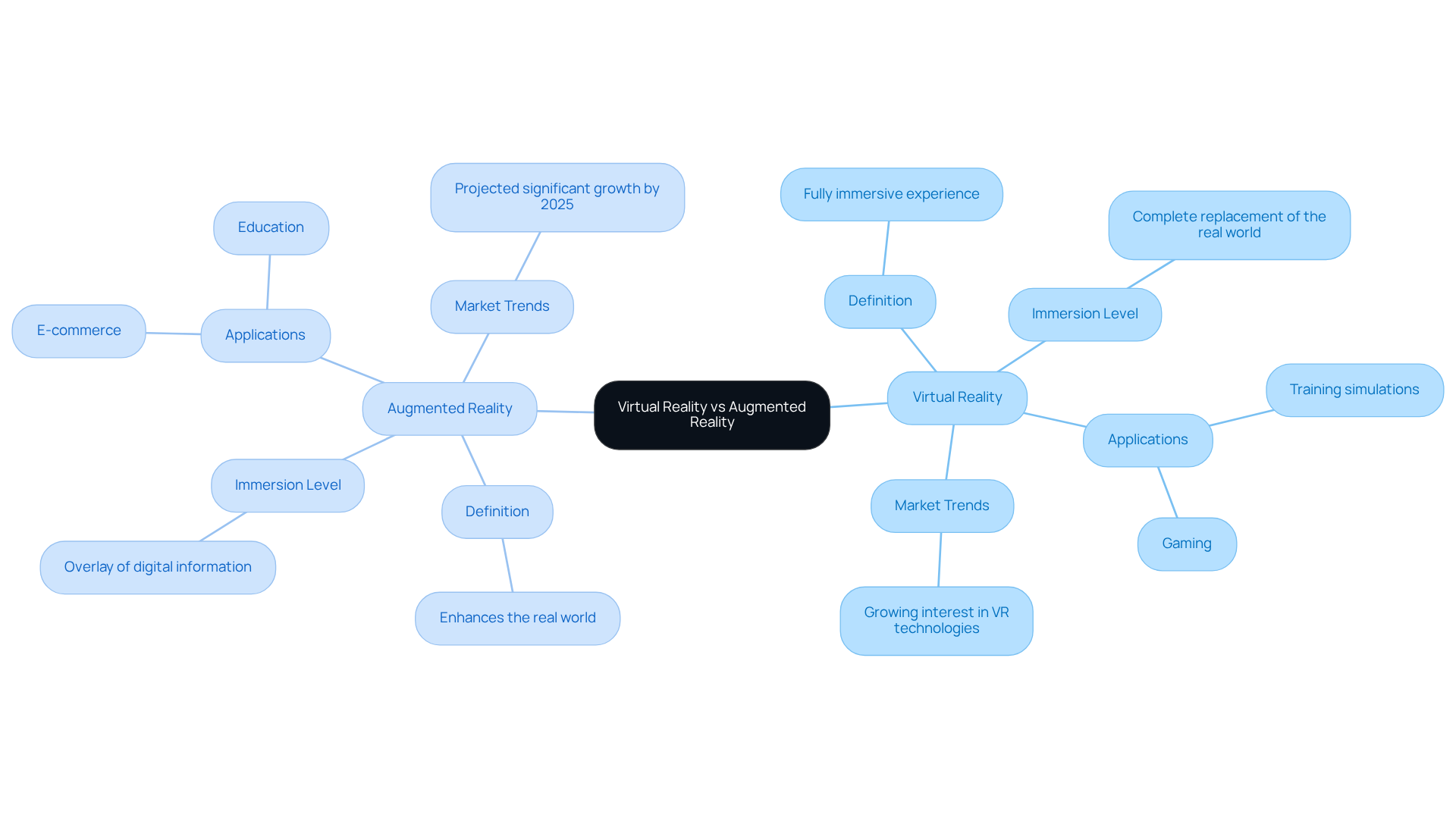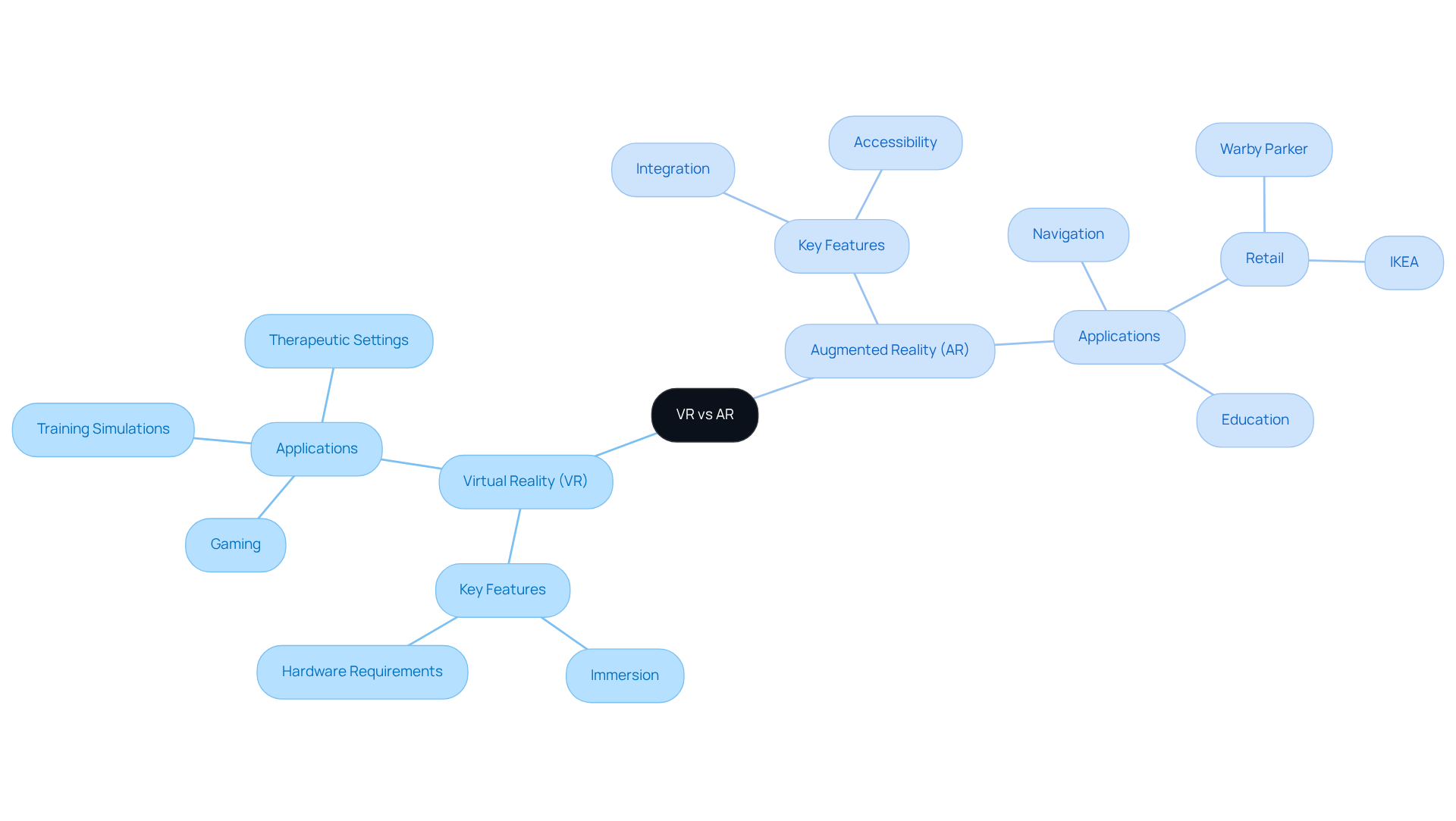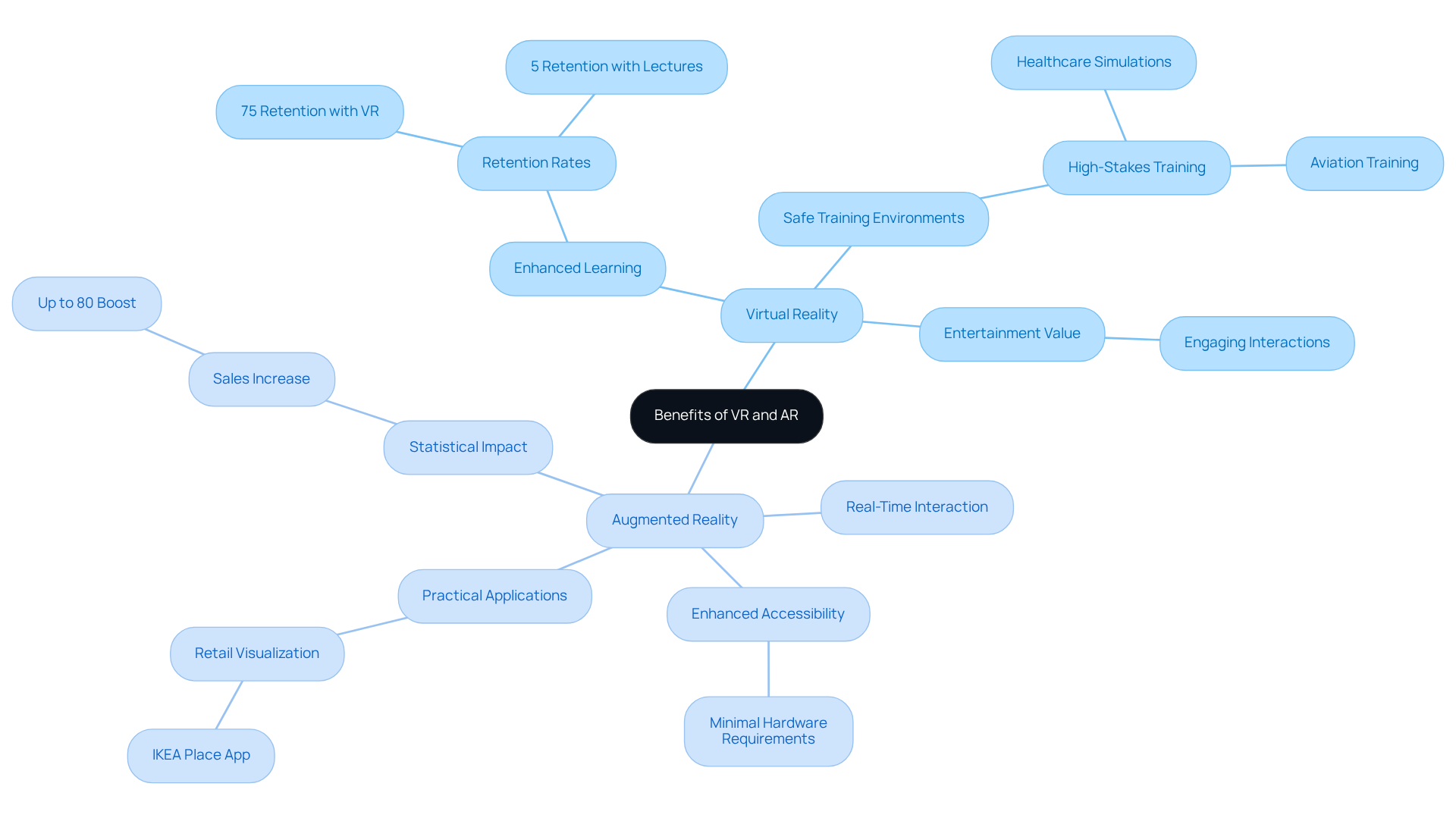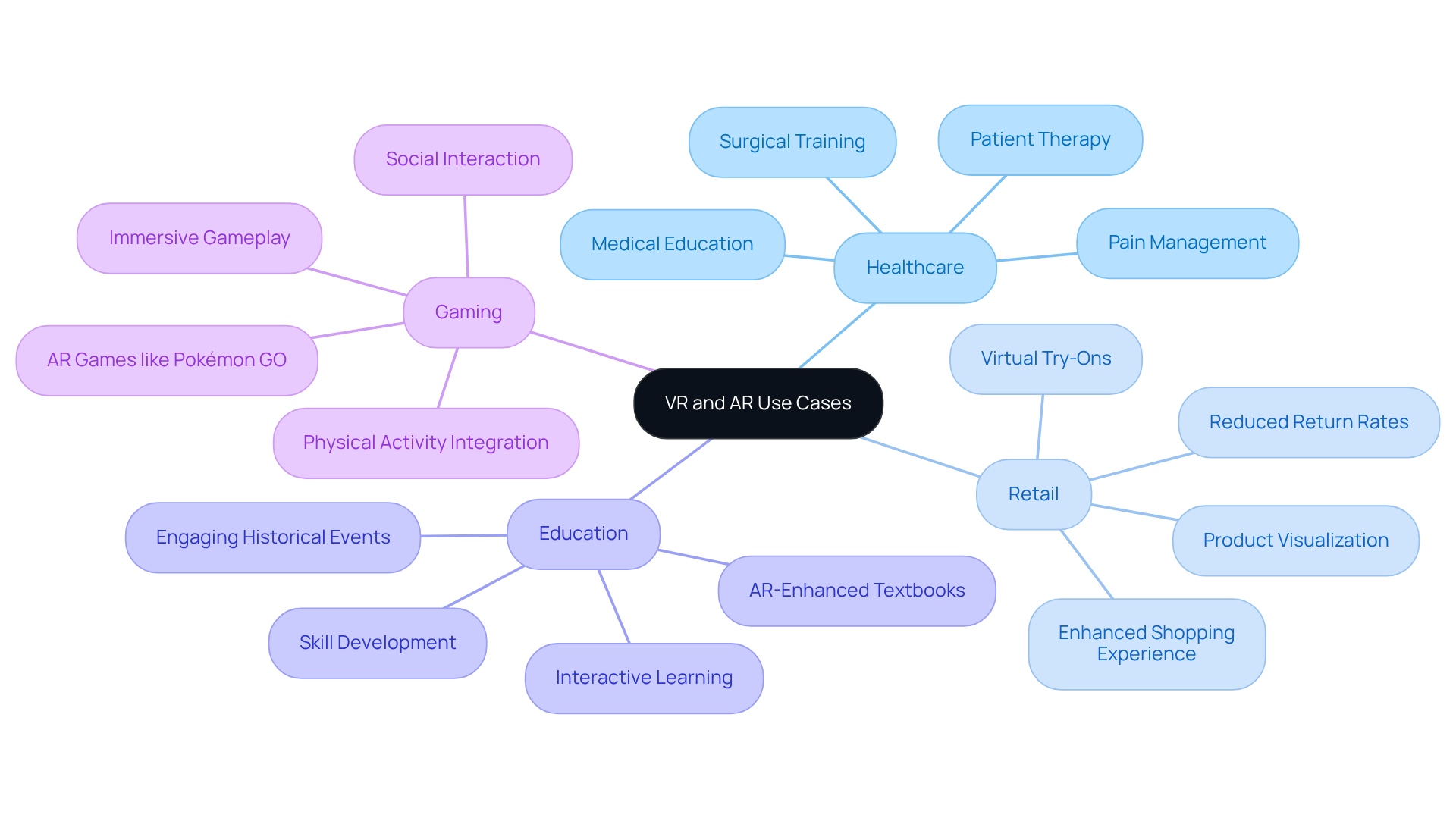Overview
The fundamental distinctions between Virtual Reality (VR) and Augmented Reality (AR) are rooted in their levels of immersion and interaction with the real world. VR provides a fully immersive experience that completely replaces the real environment. In contrast, AR overlays digital information onto the physical world, thereby enhancing it without full substitution. This critical difference is further illustrated through a detailed exploration of each technology's applications, benefits, and unique features.
Research indicates that:
- VR excels in training and entertainment.
- AR significantly enhances practicality in everyday activities such as shopping and education.
Understanding these differences is essential for brand managers seeking to leverage these technologies effectively.
Introduction
The rapid evolution of technology has ushered in two groundbreaking realms: Virtual Reality (VR) and Augmented Reality (AR). VR immerses users in entirely simulated environments, while AR enhances the real world by overlaying digital information onto it, creating a unique blend of reality and imagination. As these technologies gain traction across various industries, understanding their distinct features and benefits becomes crucial.
What challenges do businesses face in harnessing the full potential of VR and AR? How can they leverage these innovations to enhance customer experiences and drive success? The answers to these questions are vital for organizations aiming to stay ahead in a competitive landscape.
Define Virtual Reality and Augmented Reality
Virtual Reality (VR) offers a fully immersive experience, completely replacing the real world with a simulated environment accessed through specialized headsets. Users are transported into a digital realm where they can interact with 3D objects and environments as if they were tangible.
In contrast, Augmented Reality (AR) enhances the real world by overlaying digital information, enabling individuals to perceive their environment through devices like smartphones or AR glasses. This integration allows individuals to view and engage with both real and virtual elements simultaneously, creating a combined reality that enhances perception without complete substitution.
As of 2025, the AR market is projected to experience significant growth, driven by advancements in technology and increasing consumer adoption, with applications ranging from e-commerce to education.
Magic Playbox is at the forefront of this evolution, pioneering immersive AR and XR experiences that enhance brand engagement and foster consumer loyalty.
The key distinction in virtual reality vs augmented reality lies in immersion:
- VR immerses individuals in a completely virtual space,
- AR enhances their existing environment, making both technologies invaluable in different contexts.
Tim Cook emphasizes that AR allows individuals to remain present in the world while improving their surroundings, underscoring its potential to transform customer interactions.
The time to engage with these technologies is now; leveraging VR and AR can redefine customer experiences and drive brand success.

Differentiate Key Features of VR and AR
Key features of Virtual Reality (VR) are significant and multifaceted:
- Immersion: VR creates a profound sense of presence within a fully simulated environment, often eliciting strong emotional responses from users.
- Hardware Requirements: Engaging with VR typically necessitates specialized headsets and controllers that monitor individual movements, thereby offering a completely immersive experience.
- Applications: VR is predominantly utilized in gaming, training simulations, and therapeutic settings, where complete immersion enhances learning and engagement.
Conversely, Augmented Reality (AR) presents distinct advantages:
- Integration: AR enriches the real world by overlaying digital elements, enabling users to interact seamlessly with both physical and virtual objects.
- Accessibility: AR applications generally require only a smartphone or tablet, making them accessible to a broader audience without the need for specialized equipment.
- Applications: AR is widely utilized in retail, education, and navigation, offering practical solutions that enhance daily activities. For instance, companies such as Warby Parker and IKEA employ AR to enable customers to visualize products in real-time, significantly improving engagement and decision-making.
As we approach 2025, the distinctions between virtual reality vs augmented reality technologies continue to evolve. In the context of virtual reality vs augmented reality, AR is increasingly recognized for its ability to enhance interactions in practical situations, while VR maintains its position as a leader in engaging entertainment and training options. This ongoing development underscores the importance of staying informed and adapting strategies to leverage the strengths of both technologies.

Examine Benefits of Virtual Reality and Augmented Reality
The benefits of Virtual Reality (VR) are substantial and multifaceted:
- Enhanced Learning: VR provides immersive educational experiences that significantly improve retention rates. Research indicates that retention can reach an impressive 75%, starkly contrasting with the mere 5% retention associated with traditional lectures.
- Safe Training Environments: VR creates risk-free settings for individuals to practice essential skills. This is particularly advantageous in high-stakes fields such as healthcare and aviation, where real-world practice can have critical implications.
- Entertainment Value: VR offers distinctive and captivating interactions, engaging individuals effectively. This makes it a powerful tool for both educational purposes and leisure activities.
Conversely, Augmented Reality (AR) presents its own compelling advantages:
- Real-Time Interaction: AR facilitates real-time interaction with digital content, significantly enhancing user engagement and understanding of products or services.
- Enhanced Accessibility: With minimal hardware requirements, AR can reach a broader audience, simplifying consumer engagement with immersive environments.
- Practical Applications: AR greatly enhances user experiences in retail by allowing individuals to visualize products within their own environments before making purchases. For example, brands like IKEA leverage AR technology to enable consumers to see how furniture fits in their homes, thereby boosting confidence in purchasing decisions.
- Statistical Impact: Research indicates that AR can elevate sales by up to 80% through improved client engagement. This demonstrates its effectiveness in driving retail success. Industry leaders emphasize that AR not only enriches the shopping experience but also fosters deeper connections between consumers and brands.

Explore Use Cases for VR and AR in Various Industries
In the healthcare sector, the discussion of virtual reality vs augmented reality highlights how Virtual Reality (VR) is revolutionizing surgical training and patient therapy by enabling practitioners to refine their skills in a controlled environment. VR can simulate intricate surgical procedures, offering medical students a safe platform to practice and gain confidence before operating on real patients. The VR healthcare market is projected to grow significantly, reaching $6.02 billion by 2025, driven by advancements in technology and increasing acceptance among healthcare professionals.
Conversely, the debate of virtual reality vs augmented reality highlights how Augmented Reality (AR) is transforming the retail landscape by allowing shoppers to visualize products in their own environments prior to purchase. Furniture retailers utilize AR applications that enable shoppers to see how a piece of furniture would fit and look in their homes, thereby enhancing the decision-making process and boosting customer satisfaction. Statistics indicate that AR can lower return rates by 25% to 40%, while enhancing consumer confidence in a product's quality by 56%. Furthermore, 82% of shoppers would use AR to assist in making purchasing decisions while in-store, demonstrating strong consumer interest in AR technologies.
In the field of education, VR generates engaging learning opportunities that transport students to historical events or scientific settings, promoting deeper comprehension and retention of knowledge. Meanwhile, AR enhances traditional learning by overlaying digital information onto textbooks or real-world objects, making lessons more interactive and engaging for students.
In the gaming sector, the debate of virtual reality vs augmented reality highlights how VR delivers fully immersive simulations that captivate players, while AR offers interactive gameplay that integrates seamlessly with the real world. A prime example is Pokémon GO, which has popularized AR by encouraging players to explore their surroundings while engaging in gameplay, thus blending entertainment with physical activity. Moreover, businesses such as Warby Parker are utilizing AR for virtual try-ons, demonstrating how AR can generate new revenue sources and improve client interaction.
Magic Playbox is at the forefront of these innovations, pioneering immersive AR and XR interactions that not only enhance customer engagement but also foster brand loyalty in e-commerce. By integrating AR solutions into retail strategies, Magic Playbox assists brands in creating interactive experiences that resonate with consumers, ultimately driving sales and reducing return rates.

Conclusion
Virtual Reality (VR) and Augmented Reality (AR) represent two distinct yet complementary technologies that fundamentally transform how individuals engage with both digital and physical environments. While VR immerses users in entirely virtual spaces, AR enhances real-world experiences by overlaying digital information. Understanding these differences is crucial for leveraging the unique benefits each technology offers across various industries.
The article underscores key features and applications of both VR and AR, emphasizing their respective advantages. VR excels in creating immersive learning environments and safe training scenarios, making it invaluable in sectors like healthcare and education. Meanwhile, AR facilitates real-time interaction and accessibility, significantly enhancing customer engagement in retail and other practical applications. As both technologies continue to evolve, their integration into everyday experiences becomes increasingly vital.
In conclusion, the ongoing advancements in VR and AR technologies present significant opportunities for businesses and consumers alike. Embracing these innovations can redefine customer interactions, enhance learning experiences, and drive engagement across various sectors. The time to explore and implement these technologies is now; they hold the potential to revolutionize how we perceive and interact with the world around us.
Frequently Asked Questions
What is Virtual Reality (VR)?
Virtual Reality (VR) offers a fully immersive experience that completely replaces the real world with a simulated environment accessed through specialized headsets. Users can interact with 3D objects and environments as if they were tangible.
How does Augmented Reality (AR) differ from Virtual Reality?
Augmented Reality (AR) enhances the real world by overlaying digital information, allowing individuals to perceive their environment through devices like smartphones or AR glasses. Unlike VR, which immerses users in a completely virtual space, AR integrates both real and virtual elements simultaneously.
What are the projected trends for the AR market by 2025?
As of 2025, the AR market is projected to experience significant growth driven by advancements in technology and increasing consumer adoption, with applications ranging from e-commerce to education.
What role does Magic Playbox play in AR and XR experiences?
Magic Playbox is at the forefront of the evolution of AR and XR experiences, pioneering immersive technologies that enhance brand engagement and foster consumer loyalty.
What is the key distinction between Virtual Reality and Augmented Reality?
The key distinction lies in immersion: VR immerses individuals in a completely virtual space, while AR enhances their existing environment, making both technologies invaluable in different contexts.
What does Tim Cook say about Augmented Reality?
Tim Cook emphasizes that AR allows individuals to remain present in the world while improving their surroundings, highlighting its potential to transform customer interactions.
Why is it important to engage with VR and AR technologies now?
Engaging with VR and AR technologies now can redefine customer experiences and drive brand success, making it a crucial time for businesses to leverage these innovations.




